Supporting Individuals and Communities in Crisis: A Report
VerifiedAdded on 2023/06/04
|7
|1622
|214
Report
AI Summary
This report addresses the critical importance of effective communication during health crises, emphasizing the need for timely and accessible information. It highlights the significance of oral and written communication in understandable languages, including the provision of interpreters when necessary, and the use of culturally sensitive communication techniques. The report provides guidelines for healthcare practitioners, particularly in the context of the Australian healthcare system, stressing the importance of understanding an individual's culture and its impact on their health perceptions and help-seeking behaviors. It discusses the need for cultural competence, especially when dealing with Aboriginal communities, and stresses the avoidance of misdiagnosis and culturally inappropriate communication. Furthermore, the report emphasizes the importance of creating support networks and involving family members to aid individuals in crisis, while also acknowledging the impact of historical factors and societal shame on help-seeking behavior. The report concludes by reiterating the importance of respecting cultural norms and fostering an environment where individuals feel comfortable seeking assistance.
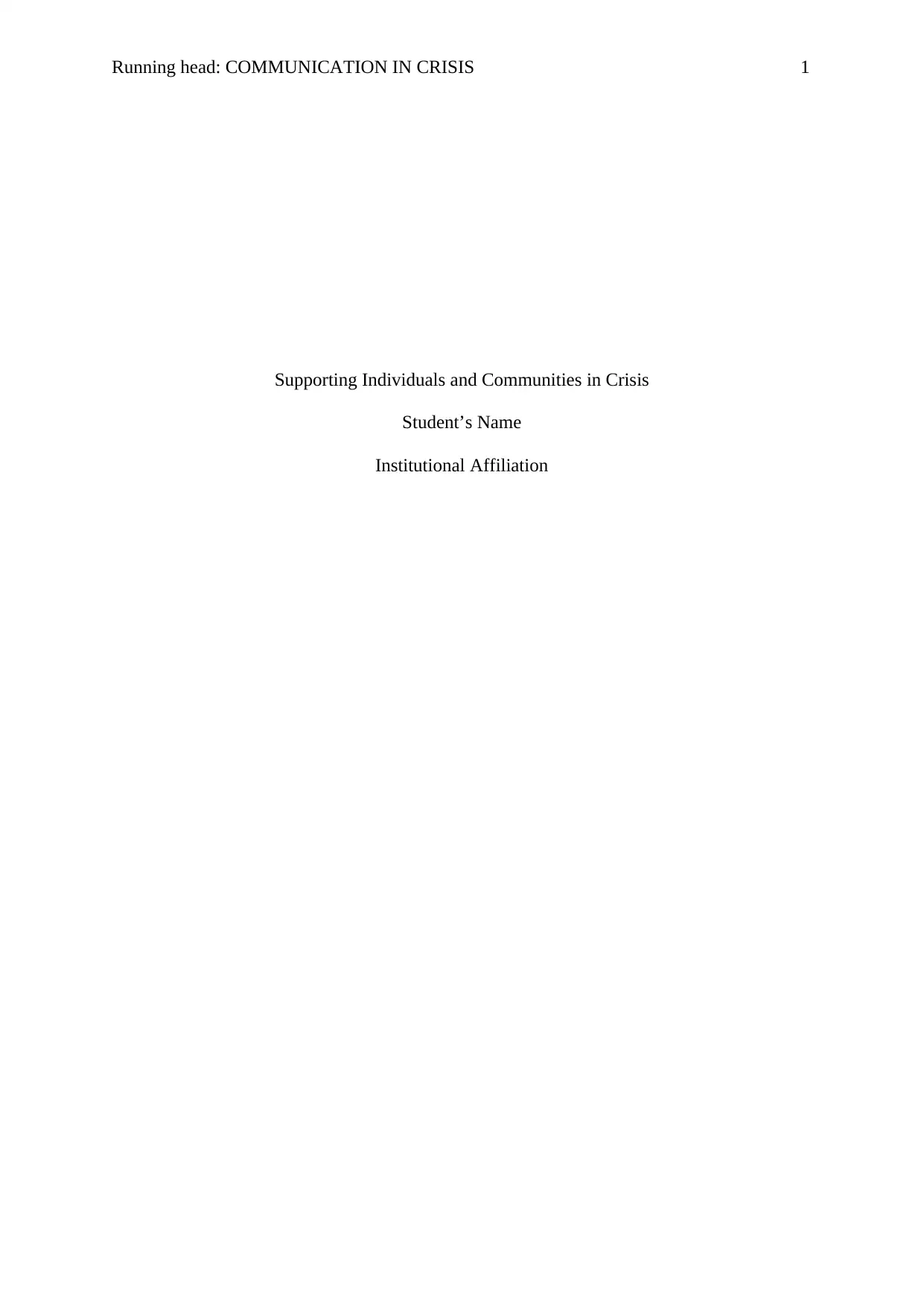
Running head: COMMUNICATION IN CRISIS 1
Supporting Individuals and Communities in Crisis
Student’s Name
Institutional Affiliation
Supporting Individuals and Communities in Crisis
Student’s Name
Institutional Affiliation
Paraphrase This Document
Need a fresh take? Get an instant paraphrase of this document with our AI Paraphraser
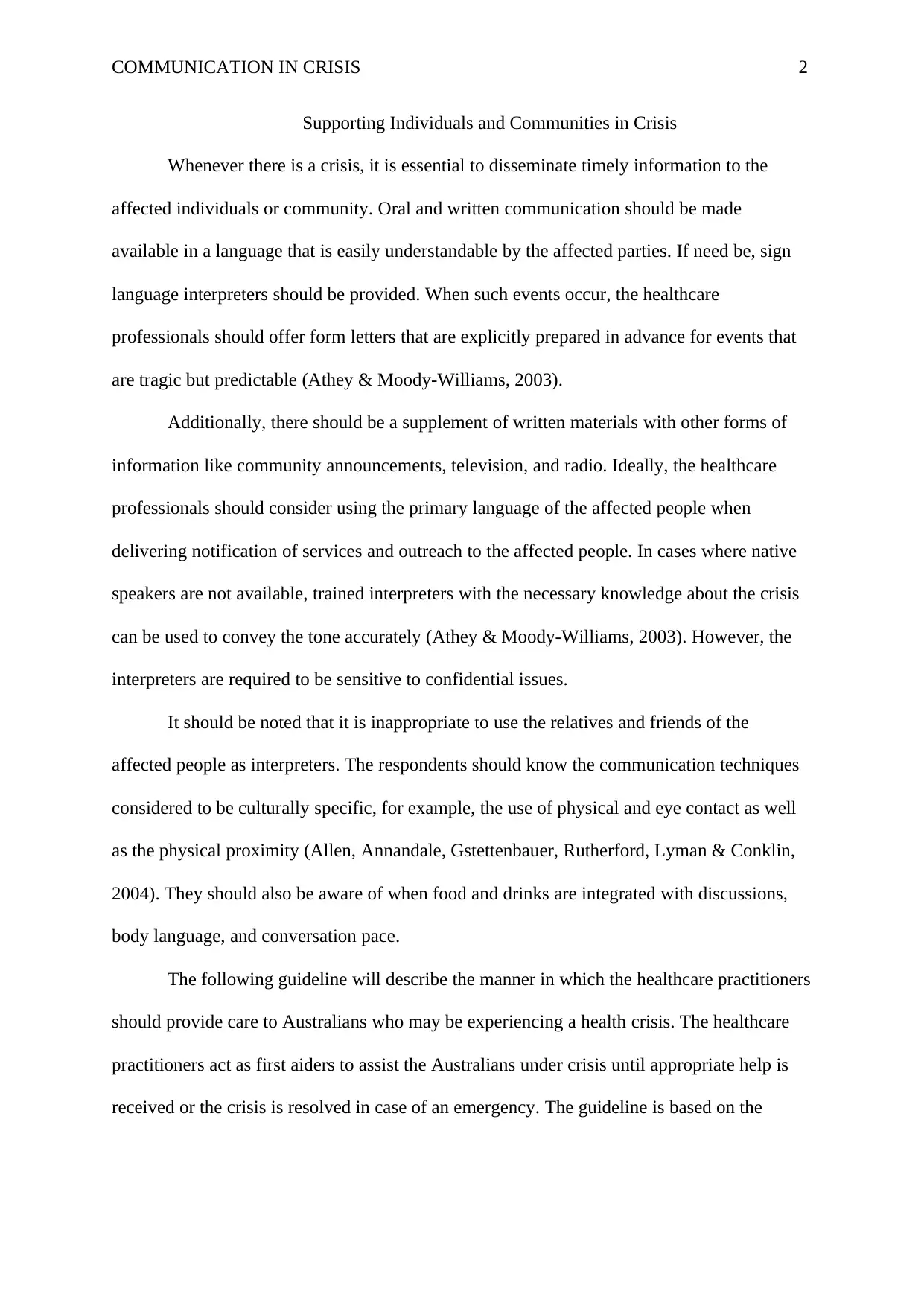
COMMUNICATION IN CRISIS 2
Supporting Individuals and Communities in Crisis
Whenever there is a crisis, it is essential to disseminate timely information to the
affected individuals or community. Oral and written communication should be made
available in a language that is easily understandable by the affected parties. If need be, sign
language interpreters should be provided. When such events occur, the healthcare
professionals should offer form letters that are explicitly prepared in advance for events that
are tragic but predictable (Athey & Moody-Williams, 2003).
Additionally, there should be a supplement of written materials with other forms of
information like community announcements, television, and radio. Ideally, the healthcare
professionals should consider using the primary language of the affected people when
delivering notification of services and outreach to the affected people. In cases where native
speakers are not available, trained interpreters with the necessary knowledge about the crisis
can be used to convey the tone accurately (Athey & Moody-Williams, 2003). However, the
interpreters are required to be sensitive to confidential issues.
It should be noted that it is inappropriate to use the relatives and friends of the
affected people as interpreters. The respondents should know the communication techniques
considered to be culturally specific, for example, the use of physical and eye contact as well
as the physical proximity (Allen, Annandale, Gstettenbauer, Rutherford, Lyman & Conklin,
2004). They should also be aware of when food and drinks are integrated with discussions,
body language, and conversation pace.
The following guideline will describe the manner in which the healthcare practitioners
should provide care to Australians who may be experiencing a health crisis. The healthcare
practitioners act as first aiders to assist the Australians under crisis until appropriate help is
received or the crisis is resolved in case of an emergency. The guideline is based on the
Supporting Individuals and Communities in Crisis
Whenever there is a crisis, it is essential to disseminate timely information to the
affected individuals or community. Oral and written communication should be made
available in a language that is easily understandable by the affected parties. If need be, sign
language interpreters should be provided. When such events occur, the healthcare
professionals should offer form letters that are explicitly prepared in advance for events that
are tragic but predictable (Athey & Moody-Williams, 2003).
Additionally, there should be a supplement of written materials with other forms of
information like community announcements, television, and radio. Ideally, the healthcare
professionals should consider using the primary language of the affected people when
delivering notification of services and outreach to the affected people. In cases where native
speakers are not available, trained interpreters with the necessary knowledge about the crisis
can be used to convey the tone accurately (Athey & Moody-Williams, 2003). However, the
interpreters are required to be sensitive to confidential issues.
It should be noted that it is inappropriate to use the relatives and friends of the
affected people as interpreters. The respondents should know the communication techniques
considered to be culturally specific, for example, the use of physical and eye contact as well
as the physical proximity (Allen, Annandale, Gstettenbauer, Rutherford, Lyman & Conklin,
2004). They should also be aware of when food and drinks are integrated with discussions,
body language, and conversation pace.
The following guideline will describe the manner in which the healthcare practitioners
should provide care to Australians who may be experiencing a health crisis. The healthcare
practitioners act as first aiders to assist the Australians under crisis until appropriate help is
received or the crisis is resolved in case of an emergency. The guideline is based on the
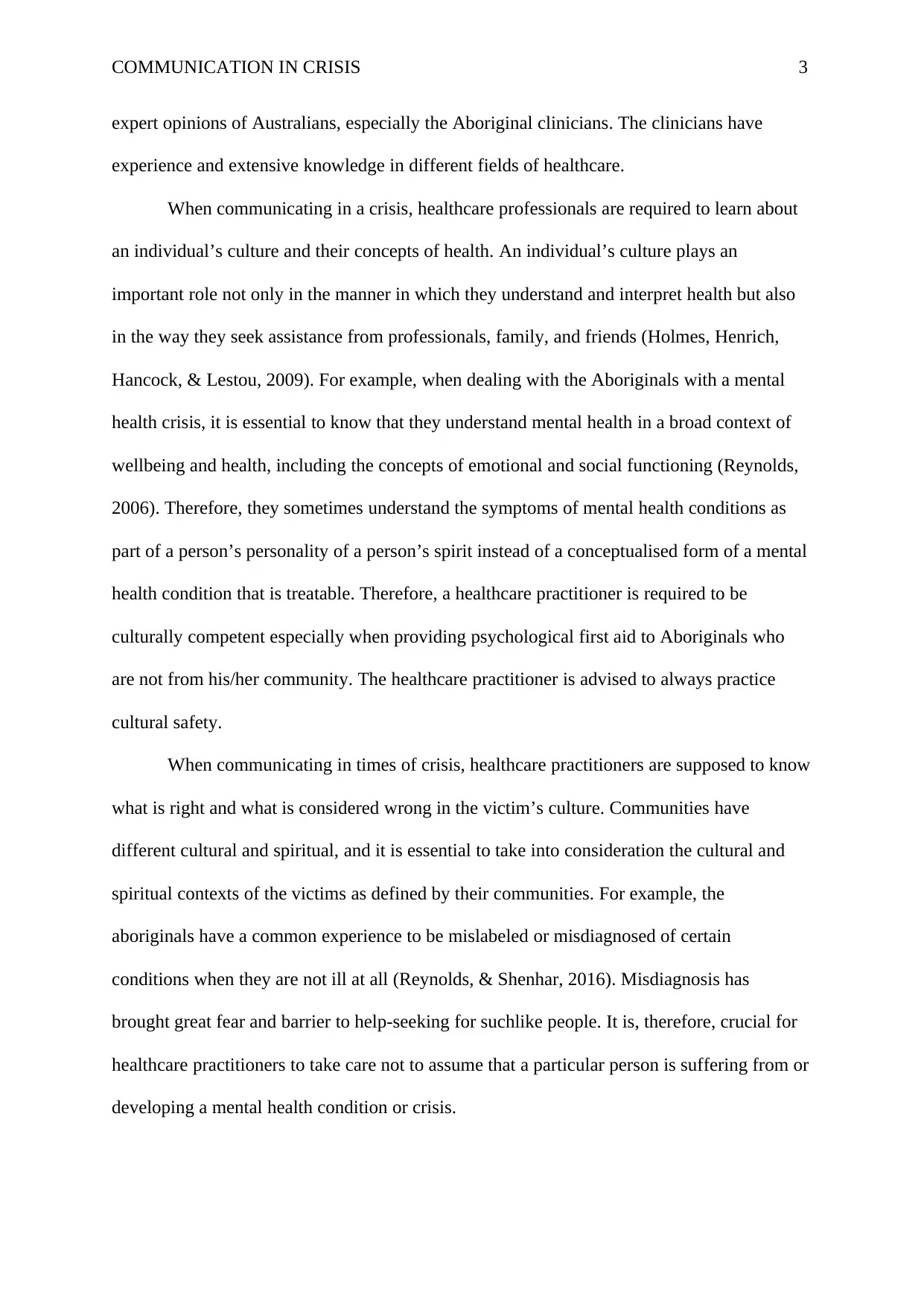
COMMUNICATION IN CRISIS 3
expert opinions of Australians, especially the Aboriginal clinicians. The clinicians have
experience and extensive knowledge in different fields of healthcare.
When communicating in a crisis, healthcare professionals are required to learn about
an individual’s culture and their concepts of health. An individual’s culture plays an
important role not only in the manner in which they understand and interpret health but also
in the way they seek assistance from professionals, family, and friends (Holmes, Henrich,
Hancock, & Lestou, 2009). For example, when dealing with the Aboriginals with a mental
health crisis, it is essential to know that they understand mental health in a broad context of
wellbeing and health, including the concepts of emotional and social functioning (Reynolds,
2006). Therefore, they sometimes understand the symptoms of mental health conditions as
part of a person’s personality of a person’s spirit instead of a conceptualised form of a mental
health condition that is treatable. Therefore, a healthcare practitioner is required to be
culturally competent especially when providing psychological first aid to Aboriginals who
are not from his/her community. The healthcare practitioner is advised to always practice
cultural safety.
When communicating in times of crisis, healthcare practitioners are supposed to know
what is right and what is considered wrong in the victim’s culture. Communities have
different cultural and spiritual, and it is essential to take into consideration the cultural and
spiritual contexts of the victims as defined by their communities. For example, the
aboriginals have a common experience to be mislabeled or misdiagnosed of certain
conditions when they are not ill at all (Reynolds, & Shenhar, 2016). Misdiagnosis has
brought great fear and barrier to help-seeking for suchlike people. It is, therefore, crucial for
healthcare practitioners to take care not to assume that a particular person is suffering from or
developing a mental health condition or crisis.
expert opinions of Australians, especially the Aboriginal clinicians. The clinicians have
experience and extensive knowledge in different fields of healthcare.
When communicating in a crisis, healthcare professionals are required to learn about
an individual’s culture and their concepts of health. An individual’s culture plays an
important role not only in the manner in which they understand and interpret health but also
in the way they seek assistance from professionals, family, and friends (Holmes, Henrich,
Hancock, & Lestou, 2009). For example, when dealing with the Aboriginals with a mental
health crisis, it is essential to know that they understand mental health in a broad context of
wellbeing and health, including the concepts of emotional and social functioning (Reynolds,
2006). Therefore, they sometimes understand the symptoms of mental health conditions as
part of a person’s personality of a person’s spirit instead of a conceptualised form of a mental
health condition that is treatable. Therefore, a healthcare practitioner is required to be
culturally competent especially when providing psychological first aid to Aboriginals who
are not from his/her community. The healthcare practitioner is advised to always practice
cultural safety.
When communicating in times of crisis, healthcare practitioners are supposed to know
what is right and what is considered wrong in the victim’s culture. Communities have
different cultural and spiritual, and it is essential to take into consideration the cultural and
spiritual contexts of the victims as defined by their communities. For example, the
aboriginals have a common experience to be mislabeled or misdiagnosed of certain
conditions when they are not ill at all (Reynolds, & Shenhar, 2016). Misdiagnosis has
brought great fear and barrier to help-seeking for suchlike people. It is, therefore, crucial for
healthcare practitioners to take care not to assume that a particular person is suffering from or
developing a mental health condition or crisis.
⊘ This is a preview!⊘
Do you want full access?
Subscribe today to unlock all pages.

Trusted by 1+ million students worldwide
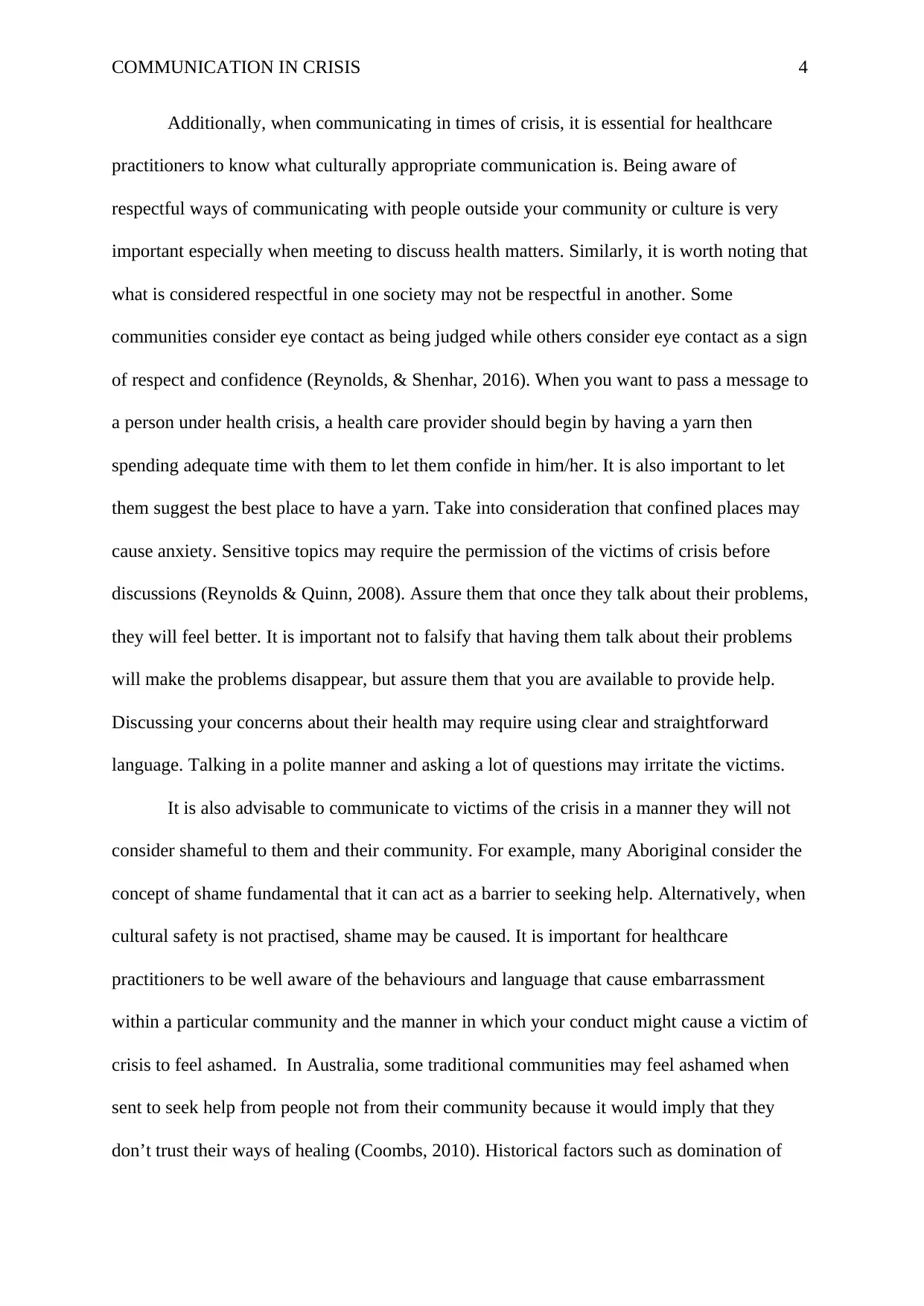
COMMUNICATION IN CRISIS 4
Additionally, when communicating in times of crisis, it is essential for healthcare
practitioners to know what culturally appropriate communication is. Being aware of
respectful ways of communicating with people outside your community or culture is very
important especially when meeting to discuss health matters. Similarly, it is worth noting that
what is considered respectful in one society may not be respectful in another. Some
communities consider eye contact as being judged while others consider eye contact as a sign
of respect and confidence (Reynolds, & Shenhar, 2016). When you want to pass a message to
a person under health crisis, a health care provider should begin by having a yarn then
spending adequate time with them to let them confide in him/her. It is also important to let
them suggest the best place to have a yarn. Take into consideration that confined places may
cause anxiety. Sensitive topics may require the permission of the victims of crisis before
discussions (Reynolds & Quinn, 2008). Assure them that once they talk about their problems,
they will feel better. It is important not to falsify that having them talk about their problems
will make the problems disappear, but assure them that you are available to provide help.
Discussing your concerns about their health may require using clear and straightforward
language. Talking in a polite manner and asking a lot of questions may irritate the victims.
It is also advisable to communicate to victims of the crisis in a manner they will not
consider shameful to them and their community. For example, many Aboriginal consider the
concept of shame fundamental that it can act as a barrier to seeking help. Alternatively, when
cultural safety is not practised, shame may be caused. It is important for healthcare
practitioners to be well aware of the behaviours and language that cause embarrassment
within a particular community and the manner in which your conduct might cause a victim of
crisis to feel ashamed. In Australia, some traditional communities may feel ashamed when
sent to seek help from people not from their community because it would imply that they
don’t trust their ways of healing (Coombs, 2010). Historical factors such as domination of
Additionally, when communicating in times of crisis, it is essential for healthcare
practitioners to know what culturally appropriate communication is. Being aware of
respectful ways of communicating with people outside your community or culture is very
important especially when meeting to discuss health matters. Similarly, it is worth noting that
what is considered respectful in one society may not be respectful in another. Some
communities consider eye contact as being judged while others consider eye contact as a sign
of respect and confidence (Reynolds, & Shenhar, 2016). When you want to pass a message to
a person under health crisis, a health care provider should begin by having a yarn then
spending adequate time with them to let them confide in him/her. It is also important to let
them suggest the best place to have a yarn. Take into consideration that confined places may
cause anxiety. Sensitive topics may require the permission of the victims of crisis before
discussions (Reynolds & Quinn, 2008). Assure them that once they talk about their problems,
they will feel better. It is important not to falsify that having them talk about their problems
will make the problems disappear, but assure them that you are available to provide help.
Discussing your concerns about their health may require using clear and straightforward
language. Talking in a polite manner and asking a lot of questions may irritate the victims.
It is also advisable to communicate to victims of the crisis in a manner they will not
consider shameful to them and their community. For example, many Aboriginal consider the
concept of shame fundamental that it can act as a barrier to seeking help. Alternatively, when
cultural safety is not practised, shame may be caused. It is important for healthcare
practitioners to be well aware of the behaviours and language that cause embarrassment
within a particular community and the manner in which your conduct might cause a victim of
crisis to feel ashamed. In Australia, some traditional communities may feel ashamed when
sent to seek help from people not from their community because it would imply that they
don’t trust their ways of healing (Coombs, 2010). Historical factors such as domination of
Paraphrase This Document
Need a fresh take? Get an instant paraphrase of this document with our AI Paraphraser
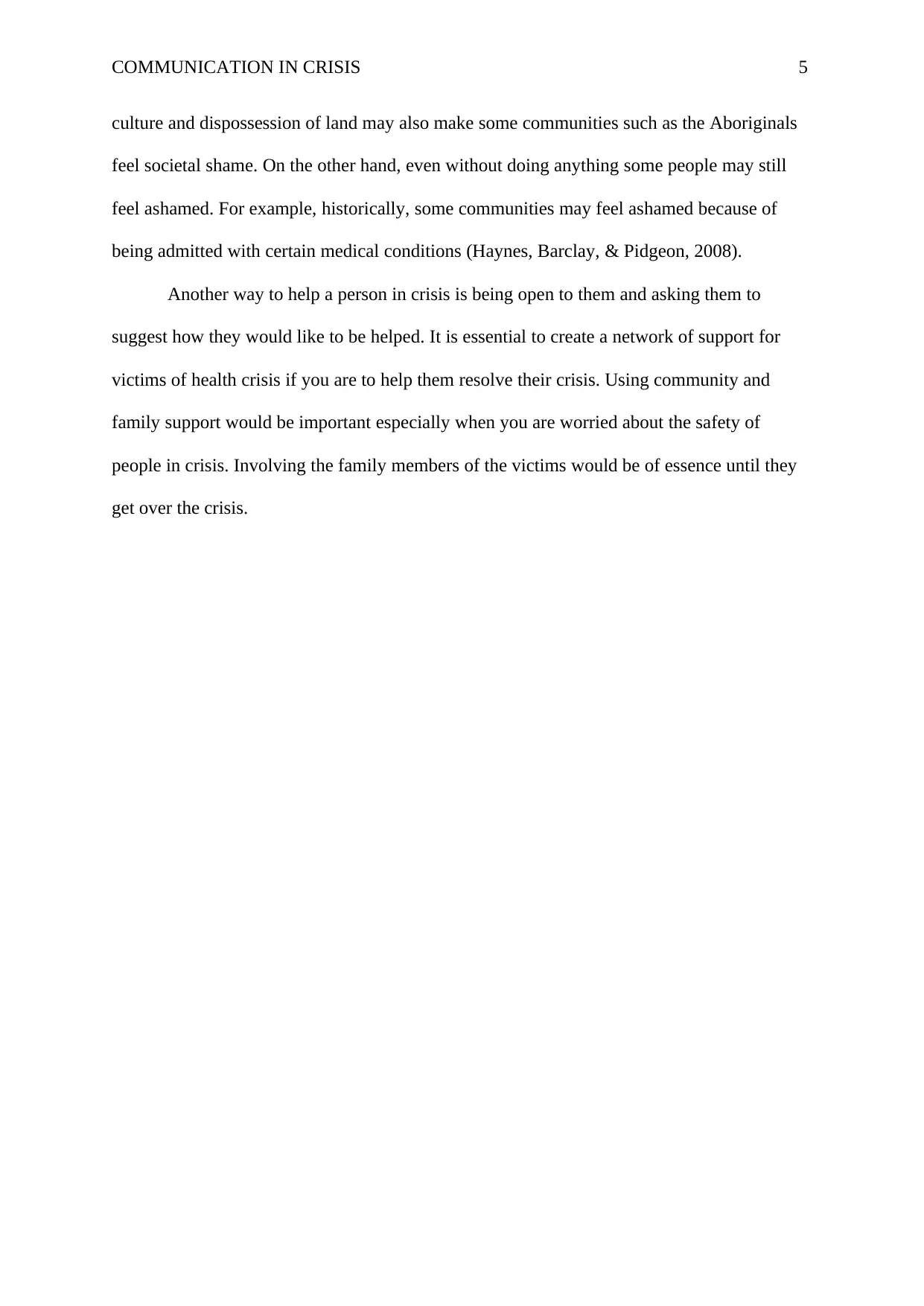
COMMUNICATION IN CRISIS 5
culture and dispossession of land may also make some communities such as the Aboriginals
feel societal shame. On the other hand, even without doing anything some people may still
feel ashamed. For example, historically, some communities may feel ashamed because of
being admitted with certain medical conditions (Haynes, Barclay, & Pidgeon, 2008).
Another way to help a person in crisis is being open to them and asking them to
suggest how they would like to be helped. It is essential to create a network of support for
victims of health crisis if you are to help them resolve their crisis. Using community and
family support would be important especially when you are worried about the safety of
people in crisis. Involving the family members of the victims would be of essence until they
get over the crisis.
culture and dispossession of land may also make some communities such as the Aboriginals
feel societal shame. On the other hand, even without doing anything some people may still
feel ashamed. For example, historically, some communities may feel ashamed because of
being admitted with certain medical conditions (Haynes, Barclay, & Pidgeon, 2008).
Another way to help a person in crisis is being open to them and asking them to
suggest how they would like to be helped. It is essential to create a network of support for
victims of health crisis if you are to help them resolve their crisis. Using community and
family support would be important especially when you are worried about the safety of
people in crisis. Involving the family members of the victims would be of essence until they
get over the crisis.
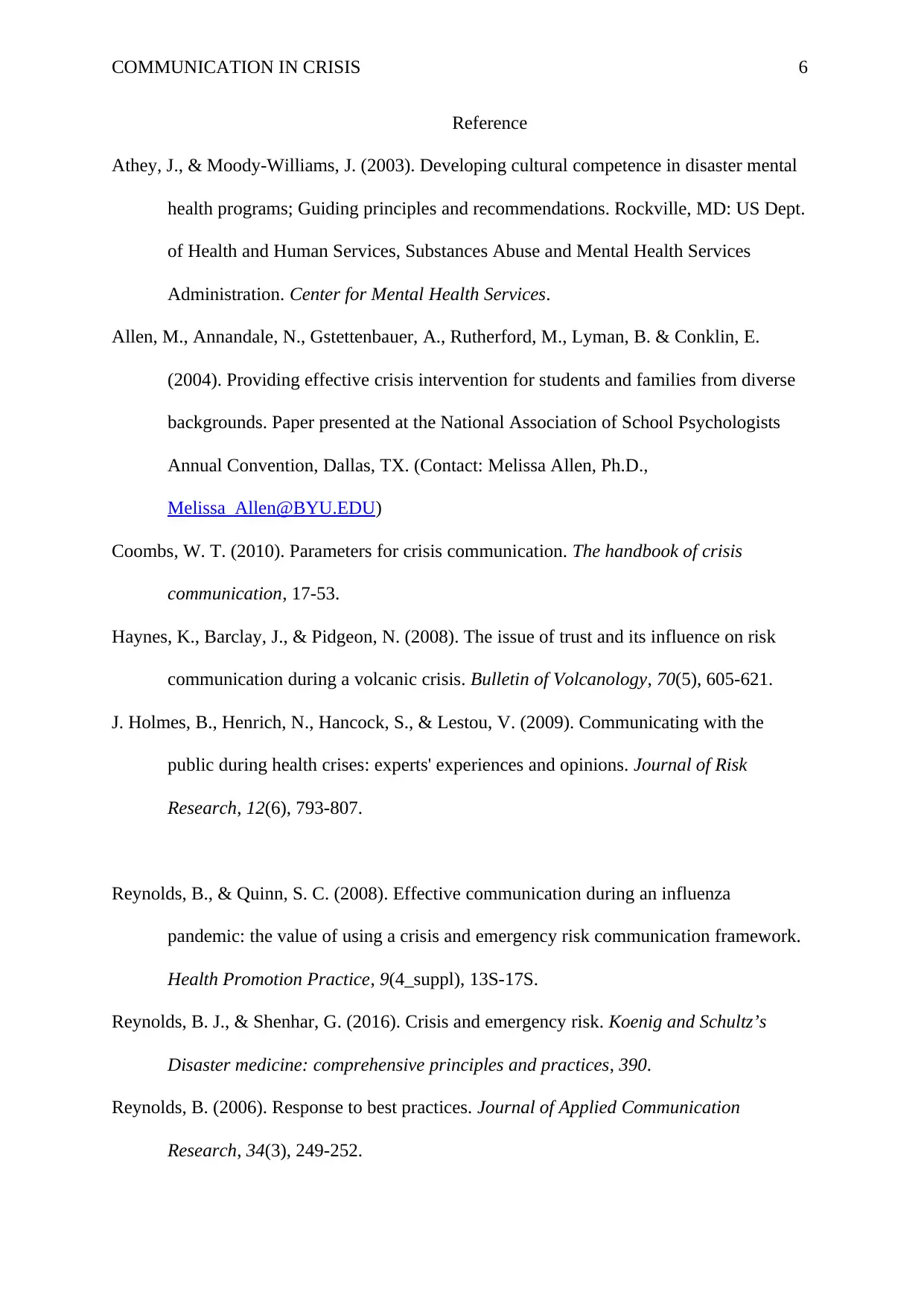
COMMUNICATION IN CRISIS 6
Reference
Athey, J., & Moody-Williams, J. (2003). Developing cultural competence in disaster mental
health programs; Guiding principles and recommendations. Rockville, MD: US Dept.
of Health and Human Services, Substances Abuse and Mental Health Services
Administration. Center for Mental Health Services.
Allen, M., Annandale, N., Gstettenbauer, A., Rutherford, M., Lyman, B. & Conklin, E.
(2004). Providing effective crisis intervention for students and families from diverse
backgrounds. Paper presented at the National Association of School Psychologists
Annual Convention, Dallas, TX. (Contact: Melissa Allen, Ph.D.,
Melissa_Allen@BYU.EDU)
Coombs, W. T. (2010). Parameters for crisis communication. The handbook of crisis
communication, 17-53.
Haynes, K., Barclay, J., & Pidgeon, N. (2008). The issue of trust and its influence on risk
communication during a volcanic crisis. Bulletin of Volcanology, 70(5), 605-621.
J. Holmes, B., Henrich, N., Hancock, S., & Lestou, V. (2009). Communicating with the
public during health crises: experts' experiences and opinions. Journal of Risk
Research, 12(6), 793-807.
Reynolds, B., & Quinn, S. C. (2008). Effective communication during an influenza
pandemic: the value of using a crisis and emergency risk communication framework.
Health Promotion Practice, 9(4_suppl), 13S-17S.
Reynolds, B. J., & Shenhar, G. (2016). Crisis and emergency risk. Koenig and Schultz’s
Disaster medicine: comprehensive principles and practices, 390.
Reynolds, B. (2006). Response to best practices. Journal of Applied Communication
Research, 34(3), 249-252.
Reference
Athey, J., & Moody-Williams, J. (2003). Developing cultural competence in disaster mental
health programs; Guiding principles and recommendations. Rockville, MD: US Dept.
of Health and Human Services, Substances Abuse and Mental Health Services
Administration. Center for Mental Health Services.
Allen, M., Annandale, N., Gstettenbauer, A., Rutherford, M., Lyman, B. & Conklin, E.
(2004). Providing effective crisis intervention for students and families from diverse
backgrounds. Paper presented at the National Association of School Psychologists
Annual Convention, Dallas, TX. (Contact: Melissa Allen, Ph.D.,
Melissa_Allen@BYU.EDU)
Coombs, W. T. (2010). Parameters for crisis communication. The handbook of crisis
communication, 17-53.
Haynes, K., Barclay, J., & Pidgeon, N. (2008). The issue of trust and its influence on risk
communication during a volcanic crisis. Bulletin of Volcanology, 70(5), 605-621.
J. Holmes, B., Henrich, N., Hancock, S., & Lestou, V. (2009). Communicating with the
public during health crises: experts' experiences and opinions. Journal of Risk
Research, 12(6), 793-807.
Reynolds, B., & Quinn, S. C. (2008). Effective communication during an influenza
pandemic: the value of using a crisis and emergency risk communication framework.
Health Promotion Practice, 9(4_suppl), 13S-17S.
Reynolds, B. J., & Shenhar, G. (2016). Crisis and emergency risk. Koenig and Schultz’s
Disaster medicine: comprehensive principles and practices, 390.
Reynolds, B. (2006). Response to best practices. Journal of Applied Communication
Research, 34(3), 249-252.
⊘ This is a preview!⊘
Do you want full access?
Subscribe today to unlock all pages.

Trusted by 1+ million students worldwide

COMMUNICATION IN CRISIS 7
1 out of 7
Related Documents
Your All-in-One AI-Powered Toolkit for Academic Success.
+13062052269
info@desklib.com
Available 24*7 on WhatsApp / Email
![[object Object]](/_next/static/media/star-bottom.7253800d.svg)
Unlock your academic potential
Copyright © 2020–2025 A2Z Services. All Rights Reserved. Developed and managed by ZUCOL.




